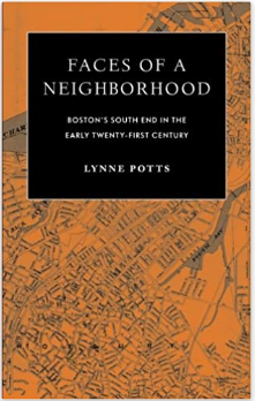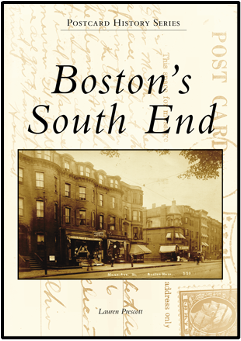
BLOG: APPLIED RESEARCH OF EMMANUEL GOSPEL CENTER
Top 5 Books for Understanding Boston
Are you looking to get a better understanding of the city of Boston with all its history, neighborhoods, and eccentricities? Rudy Mitchell, researcher of Boston's neighborhoods and churches for over 30 years, gives his top 5 recommendations for books about Boston.
Top 5 Books for Understanding Boston
BY RUDY MITCHELL, Senior Researcher, Applied Research and Consulting
No one book or even a handful of books can fully cover the many facets of the city of Boston over its nearly 400 year history. Many books cover highly specific topics, present photographic highlights, or serve an academic readership. However, the following five books give distinctive insights, diverse perspectives, and general overviews. I recommend these five because they provide a variety of viewpoints, are general in nature, and can best serve most readers in understanding Boston.
A PEOPLE’S HISTORY OF THE NEW BOSTON
BY JIM VRABEL
Although many books about Boston focus on the city’s mayors, urban planners, and prominent leaders, Vrabel focuses on community activists, the poor, and working class men and women whose protests and community organizing played an unsung role in shaping the “New Boston” over the last fifty years. This important book, based on many interviews and extensive research, covers a range of issues from housing and urban renewal to education and jobs, as well as protests against a proposed Southwest Expressway and airport expansion.
COMMON GROUND: A TURBULENT DECADE IN THE LIVES OF THREE AMERICAN FAMILIES
BY J. ANTHONY LUKAS
The Pulitzer Prize winning Common Ground probes the roots of issues related to race, class, educational disparity, and income inequality which are still critical to understand and address. This brilliant work of historical nonfiction reads like an epic novel. In the foreground are three families: the black Twymons, the Irish McGoffs, and the Yankee Divers. The larger picture is not limited to Boston during the decade of court-ordered school integration through busing of students, although the book brings that era to life in intimate detail. Lukas paints a complex picture rich with details and explorations into the historical roots of the issues. Great works like this often draw on the details of one specific place and time to understand the larger, enduring concerns of American society and its cities.
THE HUB: BOSTON PAST AND PRESENT
BY THOMAS O’CONNOR
The Hub is the best general, one volume history of Boston. O’Connor draws on a long career of research and writing about Boston to distill his insights on Boston’s resistance and adaptations to political, social, religious, and economic changes over the centuries. While creatively adapting to major changes, the city and its neighborhoods have maintained their distinctive and historical qualities without becoming frozen in time. However, O’Connor defines the current challenge facing the city as retaining “its own distinctive identity as a city whose moral standards, civic virtues, and intellectual accomplishments once inspired a nation (xiii).”
BOSTON VOICES AND VISIONS
BY SHAUN O’CONNELL, ED.
The editor of this anthology of historical and literary excerpts about Boston has selected richly descriptive pieces as well as selections that consider the high purpose and vision set forth for the city. These selections convey the flavor and everyday life of the city over the centuries, but also interpret, critique and praise the ideas, attitudes, and ideals of Boston. The book includes a wide range of authors from John Winthrop (1630), to Oliver Wendell Holmes (1831), to W.E.B. DuBois (1960), and Patricia Powell (2004).
BOSTON: A TOPOGRAPHICAL HISTORY. 3RD EDITION.
BY WALTER MUIR WHITEHILL AND LAWRENCE KENNEDY
While the title of this classic work may suggest a narrow focus, Whitehill’s book is actually an excellent introduction to the general development of Boston. The changing face of the Boston landscape and its built environment are concisely covered and generously illustrated with many pictures and maps. Some newer books go into more depth on the filling of the Back Bay and the process of urban renewal, but this work is especially helpful in understanding the first three centuries of central Boston history. Although the book does not cover the social and religious aspects of Boston in any depth, it provides a remarkable amount of detail about the city’s buildings and physical development, all in a very readable style.
For more recommended reading on Boston and its history as well as resources for walking the city, here is a fuller list of resources.
TAKE ACTION
Top 6 Books For Understanding The South End
The South End has undergone a dramatic transformation in this generation. Christian leaders in the South End can benefit from these recommended resources for foundational and ongoing learning about this dynamic community.
Top 6 Books For Understanding The South End
by Rudy Mitchell, Senior Researcher, Applied Research and Consulting
The South End has undergone a dramatic transformation in this generation. Christian leaders in the South End can benefit from these recommended resources for foundational and ongoing learning about this dynamic community.
The books I've selected are not just informative — they also illustrate methods of researching a neighborhood or community. These methods include historical research, biographical research, the use of documents and photographs, interviews, and participant observation. The books also represent different time periods from the 1890s settlement house research to very recent studies.
Once Upon a Neighborhood: A Timeline and Anecdotal History of the South End of Boston
by Alison Barnet
While Barnet’s history of the South End is not a continuous narrative, it is by far the most detailed study of the neighborhood. The book is arranged chronologically by year, with many years having multiple entries of a paragraph for each fact or anecdote. The history from the 1960s on is especially detailed since the author lived in the South End during that period. This work covers all types of businesses, publications, organizations, and churches. It does an excellent job of covering the rich diversity of groups and individuals which have lived in the South End. Some entries are associated with a founding date or initial activity, but also describe later developments up to the twentieth century. On the other hand anecdotes sometimes also review past history from the associated date. You can dive into this book at any point and find a fascinating mix of people, events and issues from a cross-section of neighborhood life.
Boston’s South End: The Clash of Ideas in a Historic Neighborhood
by Russ Lopez
The South End is a complex neighborhood which has experienced many waves of change. This is the only full length book to narrate and interpret the overall history of this diverse community. Lopez notes some truth in the standard narrative of the neighborhood rising, declining, and gentrifying, but says the fuller story is more multifaceted and nuanced. Since this has been a multi-racial, multi-ethnic neighborhood for over 125 years, it offers many lessons in conflict resolution and community organizing for other urban neighborhoods. The chapter on religion in the South End describes several major institutions, but fails to cover some of the largest Protestant churches. Although the book contains occasional factual errors, it is the most comprehensive history of the South End.
A Block in Time: History of Boston's South End Through a Window on Holyoke Street
by Lynne Potts
See also by the same author, Faces of a Neighborhood: Boston’s South End in the Early Twenty-first Century.
Lynne Potts, a long term resident, writes with flair and adds a personal touch to her concise history of the South End. She also gives those interested in the research process glimpses of her own research methods including trips to archives and libraries as well as detailed first hand observations and interviews. Although the book includes enough general information to understand the neighborhood’s development and trends, its unique contribution is the author’s personal perspectives and experiences woven into the general narrative. The approach of studying a neighborhood beginning with an in-depth look at one typical block works well here because the people, events, and experiences described are representative of the larger neighborhood over the last several decades.
Boston’s South End
by Anthony Mitchell Sammarco
See also by the same author, Boston’s South End: Then and Now.
The Arcadia Images of America Series books are full of historical photos with detailed descriptions and introductions for each of the towns and neighborhoods covered. While these do not give full histories of the communities, they do help the casual reader absorb a visual sense of the history and learn many detailed facts. Photos are organized in chapters about churches, schools, hospitals, businesses, libraries, transportation and other institutions. Many of the photographs show buildings, but quite anumber also include groups of everyday people. By learning about the history of your neighborhood you can join with others interested in history, have common ground for conversations, and gain an understanding of community identity.
Legendary Locals of Boston's South End
by Hope J. Shannon
While a neighborhood like the South End has many historical buildings, its current and past residents are the most interesting and important aspect of what makes it a community. Hope Shannon presents short, illustrated biographies of women and men of the past and recent times who have made significant contributions to the community and wider world. Shannon selects famous, infamous, and everyday people from many walks of life for Legendary Locals. The biographies range from Alexander Graham Bell, Louisa May Alcott, Rev. A.J. Gordon, and Cardinal Richard Cushing to former Mayor James Michael Curley. People who have lived in the South End of Boston over the last several decades will enjoy reading about historical figures and familiar faces, while newer residents and future generations will benefit from the careful research behind all of these biographies.
The City Wilderness: A Settlement Study
by Robert A. Woods, (editor)
In the 1890s the South End House was established as a settlement house, and the residents and associates began living in and researching the neighborhood. This classic book was the result of that research. Although the language and views were shaped by the culture and ideas of that time period, the research opens a window into the lives of South Enders at the turn of the century. The topics covered include history, description of the population, public health, employment, politics, “criminal tendencies,” recreation, the church, education, social agencies and charitable organizations (including an analysis of their methods). The most fascinating elements of the book are three color coded maps indicating for each block, the types of buildings, the nationalities of residents, and the types of employment of the workers. The book can be accessed online at Google books.
Other more specialized books on the South End
South End Character: Speaking Out on Neighborhood Change
by Alison Barnet
While the book Legendary Locals of Boston's South End highlights South Enders who achieved some prominence or fame, in contrast South End Character gives us a window into the lives of the lesser known “old South Enders.” Barnet also contrasts the perspectives and lifestyles of long-time residents and wealthier newcomers. Many of the chapters are reflections and sketches of people and life in the 1960s and 1970s. These short essays originally appeared as columns in the South End News. The look backward is not just a nostalgic reminisce, but an examination of values and issues in a changing neighborhood. Alison Barnet has also written several other books including South End Incident: A True Story.
Faces of a Neighborhood: Boston’s South End in the Early Twenty-first Century
by Lynne Potts
In this second book on the South End, author Lynne Potts interviewed 24 diverse neighborhood residents. The interviews draw out insights on contemporary issues facing people living in the city today. The 24 South Enders included people from different age groups, economic groups, as well as people who were long-time residents and newcomers.
Boston’s South End
by Lauren Prescott
This annotated collection of South End related postcards covers the period from the late 19th century to the mid Twentieth century. This is not a complete history, but it does have extensive notes with its many pictures of South End churches, hospitals, charity organizations, and businesses. For example, the book gives details on Rev. Edgar J. Helms’ development of Morgan Memorial Goodwill Industries, as well as historical notes on the Salvation Army, the Union Rescue Mission, the Woman’s Christian Temperance Union, the YWCA, and the Woman’s Foreign Missionary Society (founded in the South End). Other chapters cover schools and education; hotels and recreation; and businesses and industry.
Villa Victoria: The Transformation of Social Capital in a Boston Barrio
by Mario Luis Small
Villa Victoria has been a national model of community development. This study looks at the relationship of poverty and social capital, finding in Villa Victoria that poorer urban communities are not necessarily lacking in social capital.
Good Neighbors: Gentrifying Diversity in Boston's South End
by Sylvie Tissot, (translated by David Broder and Catherine Romatowski)
A French Marxist’s perspective on gentrification in the South End based on participant observation and interview research in neighborhood associations and networks.
Take Action
Keywords
- #ChurchToo
- 365 Campaign
- ARC Highlights
- ARC Services
- AbNet
- Abolition Network
- Action Guides
- Administration
- Adoption
- Aggressive Procedures
- Andrew Tsou
- Annual Report
- Anti-Gun
- Anti-racism education
- Applied Research
- Applied Research and Consulting
- Ayn DuVoisin
- Balance
- Battered Women
- Berlin
- Bianca Duemling
- Bias
- Biblical Leadership
- Biblical leadership
- Black Church
- Black Church Vitality Project
- Book Recommendations
- Book Reviews
- Book reviews
- Books
- Boston
- Boston 2030
- Boston Church Directory
- Boston Churches
- Boston Education Collaborative
- Boston General
- Boston Globe
- Boston History
- Boston Islamic Center
- Boston Neighborhoods
- Boston Public Schools
- Boston-Berlin
- Brainstorming
- Brazil
- Brazilian
- COVID-19
- CUME
- Cambodian
- Cambodian Church
- Cambridge












































EGC Executive Director Jeff Bass reflects on the greatest lesson from the recent meeting of the Greater Boston Interfaith Organization at the Boston Islamic Center, attended by Sen. Elizabeth Warren and Mayor Marty Walsh.